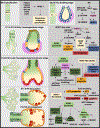Paradigms that define lung epithelial progenitor cell fate in development and regeneration
- PMID: 32587809
- PMCID: PMC7316370
- DOI: 10.1007/s40778-019-00166-x
Paradigms that define lung epithelial progenitor cell fate in development and regeneration
Abstract
Purpose of review: Throughout the lifespan, lung injury impedes the primary critical function essential for life-respiration. To repair quickly and efficiently is critical and is orchestrated by a diverse repertoire of progenitor cells and their niche. This review incorporates knowledge gained from early studies in lung epithelial morphogenesis and cell fate and explores its relevance to more recent findings of lung progenitor and stem cells in development and regeneration.
Recent findings: Cell fate in the lung is organized into an early specification phase and progressive differentiation phase in lung development. The advent of single cell analysis combined with lineage analysis and projections is uncovering new functional cell types in the lung providing a topographical atlas for progenitor cell lineage commitment during development, homeostasis, and regeneration.
Summary: Lineage commitment of lung progenitor cells is spatiotemporally regulated during development. Single cell sequencing technologies have significantly advanced our understanding of the similarities and differences between developmental and regenerative cell fate trajectories. Subsequent unraveling of the molecular mechanisms underlying these cell fate decisions will be essential to manipulating progenitor cells for regeneration.
Keywords: Lung development; cell fate; differentiation; lung regeneration; progenitor cells.
Conflict of interest statement
Conflict of Interest Aravind Sivakumar and David B. Frank declare that they have no conflict of interest
Figures

Similar articles
-
Harnessing the potential of lung stem cells for regenerative medicine.Int J Biochem Cell Biol. 2014 Nov;56:82-91. doi: 10.1016/j.biocel.2014.10.012. Epub 2014 Oct 15. Int J Biochem Cell Biol. 2014. PMID: 25450456 Review.
-
Unlocking lung regeneration: insights into progenitor cell dynamics and metabolic control.Cell Regen. 2024 Dec 16;13(1):31. doi: 10.1186/s13619-024-00212-y. Cell Regen. 2024. PMID: 39676102 Free PMC article. Review.
-
Signaling in the stem cell niche: regulating cell fate, function and plasticity.Development. 2018 Aug 1;145(15):dev165399. doi: 10.1242/dev.165399. Development. 2018. PMID: 30068689 Review.
-
The regenerative nidi of the locust midgut as a model to study epithelial cell differentiation from stem cells.J Exp Biol. 2006 Jun;209(Pt 11):2215-23. doi: 10.1242/jeb.02249. J Exp Biol. 2006. PMID: 16709922
-
Fate bias during neural regeneration adjusts dynamically without recapitulating developmental fate progression.Neural Dev. 2017 Jul 13;12(1):12. doi: 10.1186/s13064-017-0089-y. Neural Dev. 2017. PMID: 28705258 Free PMC article.
Cited by
-
Cancer metastasis as a non-healing wound.Br J Cancer. 2021 Apr;124(9):1491-1502. doi: 10.1038/s41416-021-01309-w. Epub 2021 Mar 17. Br J Cancer. 2021. PMID: 33731858 Free PMC article. Review.
-
NLRP3 inflammasome mediates abnormal epithelial regeneration and distal lung remodeling in silica‑induced lung fibrosis.Int J Mol Med. 2024 Mar;53(3):25. doi: 10.3892/ijmm.2024.5349. Epub 2024 Jan 19. Int J Mol Med. 2024. PMID: 38240085 Free PMC article.
-
Alveolar epithelial cell fate is maintained in a spatially restricted manner to promote lung regeneration after acute injury.Cell Rep. 2021 May 11;35(6):109092. doi: 10.1016/j.celrep.2021.109092. Cell Rep. 2021. PMID: 33979629 Free PMC article.
-
Staged Construction of Pluripotent Stem Cell Lung Models for Assessing Respiratory Toxicity of Environmental Pollutants.Environ Health (Wash). 2025 Jun 11;3(8):854-865. doi: 10.1021/envhealth.4c00270. eCollection 2025 Aug 15. Environ Health (Wash). 2025. PMID: 40837687 Free PMC article. Review.
References
-
- Plasschaert LW, Zilionis R, Choo-Wing R, Savova V, Knehr J, Roma G et al. A single-cell atlas of the airway epithelium reveals the CFTR-rich pulmonary ionocyte. Nature. 2018;560(7718):377–81. doi:10.1038/s41586-018-0394-6. - DOI - PMC - PubMed
-
Identifies a new recently discovered cell type called pulmonary ionocyte in the conducting airways which is a major source of CFTR (gene mutated in cystic fibrosis) activity in the lungs being regulated by Notch and FoxI1 signaling.
Grants and funding
LinkOut - more resources
Full Text Sources
Research Materials
